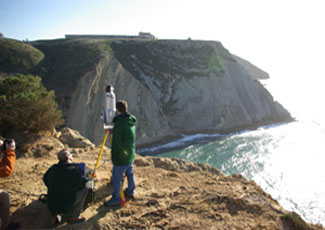Scanning of spectacular dinosaur trace fossils

This May, the Catalan Institute of Palaeontology (ICP) and the University of Manchester have once again begun to work on documenting dinosaur trace fossils (imprints) in the Iberian Peninsula. For two weeks, the team formed by palaeontologists from the two institutions will be working on different sites located in La Rioja, Soria, Teruel and Asturias using laser scanning techniques. Their work will include sited such as Los Cayos, Era del Peladillo, El Frontal, Cerradicas, Tereñes and La Griega. This is the continuation of the work they began this past December when the team documented three sites in Portugal using laser scanning techniques.
The ICP research centre receives the support of Universitat Autònoma de Barcelona and the Catalan Government. It is currently a leading centre in Catalonia in the research, conservation and dissemination of vertebrate and human palaeontology. And it recently began to introduce and apply new technologies to the different areas the centre works with. The Iberian Dino Track Tour is a clear example of how these new technologies have been incorporated to research projects related to dinosaurs, to the conservation of the past and the dissemination of scientific data.
The project's most outstanding feature is the singularity and significance of the technology used by the researchers. This technology is known as LiDAR (Light Detection and Range) which is commonly used in the field of oil prospecting and modelling. The system is based on the capturing of multiple points on a surface scanned with a laser and then combining them with georeferenced colour images in order to obtain spectacular and extremely useful three dimensional models. Although these applications in the field of ichnology (the study of trace fossils) are new researchers have obtained excellent results from the first works carried out at the dinosaur sites. This success can be seen with the results obtained in the Fumanya site (100km north of Barcelona) where in 2005 researchers digitally mapped an area of over 30,000m2 containing more than 3000 dinosaur trackways. Processing the data obtained with LiDAR technology allows scientists to study aspects which until now were unknown or difficult to obtain with traditional methods. With 3D modellings of trace fossils researchers have information about the depth, shape, size, dimensions and other aspects of the traces with millimetric precision.
The group of ichnological sites of dinosaur tracks in the Iberian Peninsula (Portugal and Spain) is the most emblematic representation of all the sites currently in the process of being declared a UNESCO World Heritage Site. The lengthy process seems to be nearing its end as the UNESCO will soon announce its verdict. Detailed documentation of these sites are undoubtedly a large and unprecedented advance in several areas. It will first of all be a fundamental tool in terms of the conservation of heritage and an ample database for detailed studies in this field. It will also open new possibilities in the dissemination of this scientific field and is a point in favour as a world heritage candidate site.


